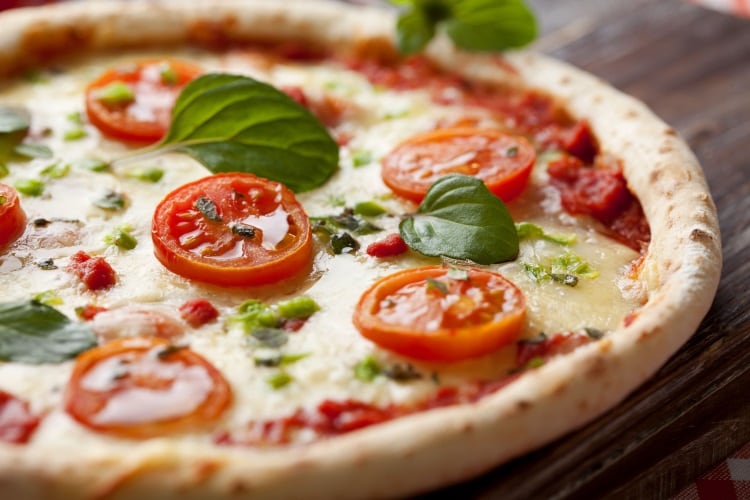Globally, the pizza market is rising as fast as a well-proofed sourdough base. According to IMARC Group, the category is expected to grow from $155.2 billion in 2024 to over $226 billion by 2033, powered by a combination of innovation, convenience, cultural relevance and a strong emotional connection with consumers.
Anne-Marie Roerink, president of 210 Analytics, emphasises the versatility of pizza in meeting diverse consumer needs. She notes that pizza offers a unique combination of indulgence and practicality, making it a staple across various demographics and occasions.
Make-your-own moments

That versatility is exactly what Elliot Cantrell, head of NPD at BakeAway, said is driving renewed interest in pizza dough, especially during the warmer months.
UK pastry and dough specialist Bakeaway – also manufacturer of Pizza Express doughs - sees “an increase in sales of pizza dough from April to September, when there’s an increase in outdoor events and social gatherings, driving the ‘make-your-own’ meal occasion,” says Cantrell. “Pizza is great for families and informal dinner parties, allowing people to cater more easily for different tastes and preferences – not to mention allowing some great creativity for little ones.”
That DIY aspect has become even more important as budget-constrained consumers look to create restaurant-style experiences at home. “Pizza is a great way for consumers to experiment and recreate a high-quality experience at a reasonable price,” says Cantrell – and thanks to social media tutorials, it’s never been easier.
Indeed, research by BakeAway found 55% of Gen Z Brits turn to TikTok for recipe inspiration and shop accordingly. Many of them entered the baking and pastry category during the lockdown and have stuck around for the creativity and community it offers. “We’re seeing younger shoppers, particularly in the 25-34 age bracket, who started experimenting during the pandemic and have now fully embraced at-home cooking as a lifestyle.”
Pizza’s emotional pull

It’s not just summer barbecues powering the pizza category. Cultural moments – from royal events to national holidays – also shape consumer behaviour in significant ways.
“Cultural events like the Coronation have a huge influence on how consumers behave towards food,” says Cantrell. “We saw a surge in shortcrust pastry sales following the Coronation Quiche in 2023, and there’s always a spike in pancakes around Pancake Day. These moments allow us to predict behaviour and lean into the emotional connection people have with food.”
That connection is especially strong when it comes to entertaining. “There’s something comforting about making food to share, to impress or to celebrate,” he adds. “Pizza fits that brief perfectly.”
Roerink agrees that emotion plays a powerful role. “Consumers are balancing the functional benefits of food with pure enjoyment. And holidays and special occasions remain important times to spend more. It’s about balancing healthy and happy.”
Trend watch

If pizza is the canvas, 2025 is the year chefs and consumers alike are painting it with bolder, spicier and more inventive brushstrokes. According to Hormel Foods, five key trends are shaping the future of the category … and they’re anything but traditional.
One of the most striking shifts in the pizza landscape is the growing appetite for heat. Thanks to younger consumers driving demand for more intense flavour profiles, chili crisp, Calabrian peppers and sriracha drizzles are becoming regular fixtures.
Alongside the heat, hot honey continues its climb as the breakout topping of the decade. Its appeal lies in the perfect balancing act between sweet and heat, transforming even a basic cheese pizza into a craveable creation.
Meanwhile, regional styles are having a renaissance. Detroit-style, grandma-esque and tavern-inspired pizzas are no longer confined to their geographic roots. They’ve become vehicles for culinary storytelling, each slice offering a taste of local heritage repackaged for a growing audience. These regional revivals aren’t just about crust and cheese, they’re about identity, nostalgia and the cultural power of food.
Gourmet meats and deli-inspired toppings are also migrating onto pizza menus. One standout is mortadella with pistachios. Inspired in part by fine dining and pop culture culinary icons, this pairing speaks to a broader trend: the desire to elevate comfort food with upscale flair.
Then there’s the comfort food crossover: a trend that blends nostalgia with novelty. Think corned beef and sauerkraut layered with Swiss cheese; meatballs with marinara; or Caesar salad reimagined on a crust.

Beyond those five, dessert pizza is no longer an outrageous suggestion. According to Roerink, 55% of Gen Z say dessert pizza (think Nutella instead of tomato sauce, sprinkles versus olives) is absolutely a thing. Compare that to just 21% of Boomers. “Flipping something like that on its head is a real opportunity,” she says.
Together, these trends underscore pizza’s evolving role as a medium for personalisation, storytelling and culinary experimentation. It remains flexible, familiar and endlessly reinterpretable.
The retail opportunity
This all adds up to serious opportunity for both manufacturers and retailers. Frozen pizza sales in the US reached $7.02 billion in 2023 and the market is expected to hit $9.6 billion in 2024, according to Mintel. Convenience, value and the desire for indulgence at home are driving much of that growth.
“Consumers are redefining the meaning of convenience,” says Roerink. “They want fast, yes – but they also want fresh, customisable and exciting. That’s a big shift. And it’s one that pizza, whether fresh, frozen or homemade, is well-positioned to deliver.”
Indeed, recent analysis by 210 Analytics conducted on behalf of the American Bakers Association (ABA) shows that Gen Z and millennials are increasingly leaning into at-home experiences that blend ease and creativity. They’re willing to spend, as long as the experience feels fun, fresh and a little bit special.
According to the Bakery Playbook survey, generational differences are stark. Older consumers are more likely to stick to tried-and-tested combos, while younger shoppers are more adventurous: open to plant-based toppings, spicy sauces and global flavour influences. “That makes innovation a non-negotiable,” says Roerink. “Brands that can surprise and delight while still offering value will win.”
Pizza’s next evolution

Expect even more innovation, more crossover and more cultural relevance in the coming months.
“As the cost-of-living crisis persists, we anticipate continued growth in at-home meal prep. People want authenticity without the expense,” says Cantrell. “That means more interest in traditional techniques, higher quality dough, better equipment – and even more playful, unexpected toppings and pairings.”
For BakeAway, this means leaning into affordability while still supporting consumer creativity. “We’re seeing a lot of interest in fusion dishes: Korean BBQ pizzas, tikka masala bases, sushi-inspired toppings,” he adds. “Pizza is evolving into a platform for expression.”
And the data backs that up. During her presentation at the recent ABA Convention in Orlando, Florida, Roerink highlighted that consumers are not only looking for food that’s convenient and delicious; they want it to reflect their values. The emphasis on people, planet and prosperity is growing stronger, especially among Gen Z and millennials. This generation cares deeply about food waste, sustainability and the environmental impact of production. Packaging, sourcing, messaging: it all matters.
“Consumers are now more discerning than ever,” Roerink explained. “They’re expecting brands to deliver products that align with their personal values and expectations.”
That’s where industry initiatives like the Bakery Playbooks come in. Developed by the American Bakers Association, the series helps members stay ahead of evolving trends and provides practical ways to innovate and grow. Two new playbooks – Pizza and Flatbread (sponsored by Lesaffre) and Doughnuts (sponsored by Dawn Foods) – were released at the 2025 Convention and are now available to members, alongside titles on Bread, Cookies, Tortillas and others (all sponsored by Puratos). The guides offer deep dives into what’s driving growth and how to stay relevant in fast-moving categories.
For the pizza segment, that means tapping into emotional eating, flavour experimentation, convenience and sustainability: all at once. Whether it’s an elevated frozen pie, a meal kit with an unexpected twist, or a simple dough that brings joy to a family night in, the product possibilities are nearly endless.
As Cantrell puts it, “Pizza isn’t just about food – it’s about experience. And the more brands can help people express themselves through food, the more they’ll win.”





